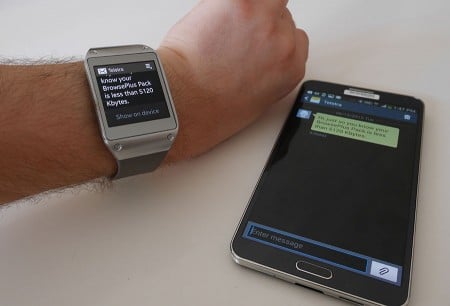Google Android (Samsung, Sony, LG, HTC, etc)
While seen by many as the number two, Google’s Android is the most used mobile operating system on the planet, activated on over a billion devices, and with 1.5 million Android devices activated daily.
Like iOS, Android relies on menus of icons to get around, but unlike iOS, the system isn’t based on one screen. Rather, there are home screens where you can add animated and constantly updating mini programs called “widgets,” designed to show you information in short bursts without loading the full application.
All the regular things that normally come with a phone are here, that said, including phone dial pad, messaging, emails, web browsers, and much more, but Google has made Android to be as customisable as humanly possible, and if you don’t like something about the look of your phone, you can generally change it very quickly.

Hate the way your home screen looks and feels? Grab a home screen replacement. You can make any Android phone look like an iPhone, a Windows Phone, the way Google wanted Android to look in the first place, or just customise until your heart’s content.
Wish the keyboard would be faster? Download a new one. Don’t like the lock screen? Replace it. Think the SMS app or phone dial screen could both look better? Fix it with a new app. Tired of the stock internet browser that came with your phone? Change it.
Android has what is easily the most configurable setup of any mobile operating system out there, and depending on how playful or artistic you are, the sky is literally the limit.
One of the downsides of this, though, is that Android can be seen as being more complicated for the casual user. Depending on the phone you buy, it certainly can be, but every manufacturer tends to have a different overlay in place to make Android look and feel different, which for many people improves the experience considerably.

Outside of the phone look and feel, though, you’ll find just as well a fleshed out app ecosystem as with iOS, though apps do generally arrive on Apple’s ecosystem first, with Android second.
That said, numerous games and apps are available on each, and Google has certainly invested heavily to make its own online services represented in application form for Android, with offline pieces of software for office replacement in Google Drive, music playback and cloud-based music services in Play Music, and the photo editing app Snapseed, to name but a few.
As for phone selection, there are more devices running Android than any other platform out there, with screen sizes ranging from 1.25 inches in smartwatches all the way up to 7 and 8 inch big phones. Most phones tend to sit between 3 and 6 inches, but Android tends to be the operating system found on most smartphones in the world, and you’ll even find a lot of experimentation from manufacturers here.

The tablet-sized phone we all call “phablets” started life as an Android experiment, and there have even been some crazy concepts with Android running on them, such as a phone with a tiny projector inside, phones with 3D screens, a version of the Sony PlayStation Portable that ran Android as a phone and had optical joysticks inside, dual-screen Android phones, and an Android mobile handset running on electronic ink technology.
Also of note is that Android has more in the “budget” smartphone space than any other operating system, and you can find inexpensive touchscreen phones for as little as $49 in Australia, with devices compatible with 4G starting at around $100.
Recommendations
Samsung Galaxy S4
Price: $899
One of the more popular phones of 2013, Samsung’s fourth-generation Galaxy flagship boasted high-end specs, 4G downloads, upgradeable memory, and even the tech to replace your TV remote. A plastic casing didn’t put the handset as high up as the HTC One for us, but it’s still an excellent phone across the board.
Sony Xperia Z1
Price: $779
Stylish and well spec’d, the Z1 is one of the more impressive smartphones you can buy, and even carries water and dust resistance, before Samsung thought it would be cool to add to its upcoming Galaxy S5. High speed 4G connectivity is offered here, too, as is a 20 megapixel camera.
HTC One
Price: $768
One of the few Android smartphones not made from plastic, the HTC One was considered one of the benchmark phones in 2013, providing an easy to use interface to Android, and matching it with a camera that worked in low-light, loud front-facing speakers, and a body made of metal.
We’re coming up to the year mark now, and so it’s getting on and a new model is expected, but as far as phones go, HTC’s One certainly made an impact.
Samsung Galaxy Note 3
Price: $999
The most successful phablet out today, the Note 3 packs in some impressive features, including the lightning fast chip used in the Sony Z1 and LG G2, support for shooting 4K videos, and Samsung’s S-Pen which can literally replace pen and paper with your smartphone. How’s that for convergence?
LG G2
Price: $699
LG’s top dog at the moment, the G2 brings best in show performance, matching it with one of the most customisable Android overlays out of the box, and support for 24-bit audio for those who love sound.
The G2 also takes advantage of one of the more unusual control schemes out there, moving the buttons to the back, which might grab you more than the regular place of the side, where all other phones have the physical buttons.
Wait for…
There’s plenty of movement in the “coming soon” section of Android world, with the Samsung Galaxy S5 on the verge of release, with the Sony Xperia Z2 likely to follow in the coming weeks, at least one new flagship HTC model, and a few more products from the other companies, including Huawei, ZTE, LG, and even Nokia.













